Practice Insights > Lessons From Practice > Education
The Inclusion of People with Disabilities
Lessons from the Association of People with Disability
By: V Santhakumar, Ankur Madan, Subrat Mishra
1. Introduction
According to official statistics, People with Disabilities (PWDs) constitute 2.21% of the Indian population. Professionals who work in this domain may consider this figure as an underestimate. The total number of PWDs, even that based on official figures of around 26.8 million, is more than the population of many countries. This includes around two million children in the age group of 0-6 years with one or more disability. The majority of PWDs live in rural areas and the percentage is slightly more among the Scheduled Castes. The major disabilities are related to speech and hearing (26%); locomotor (20%); and visual, including blindness and low vision (19%). Mental retardation and illnesses cause disabilities among 9% of PWDs.
Needless to mention that these disabilities affect the human development and welfare of the PWDs. Around 55% of the PWDs are illiterate. Two-thirds of the adult PWDs are not employed and nearly 40% of children with disabilities in the age group of 5-19 years are not attending any educational institution.
The ways in which each society manages and includes PWDs depends on the availability of institutional facilities, trained people, appropriate technology and assistive devices; and, the capability of individuals, communities and the society in utilizing these facilities. Though there are medical and rehabilitation facilities to support different forms of disabilities in major urban centres in India, these are scarce in rural areas where around 70% of the PWDs live. The general poverty and underdevelopment in the country also work against the use of such facilities even where these are available. Though there are social security schemes for PWDs in all Indian states, this support is too little considering the requirement. Even when there are legal provisions to meet the needs of the PWDs, there are financial and other constraints in the enforcement and implementation of these.
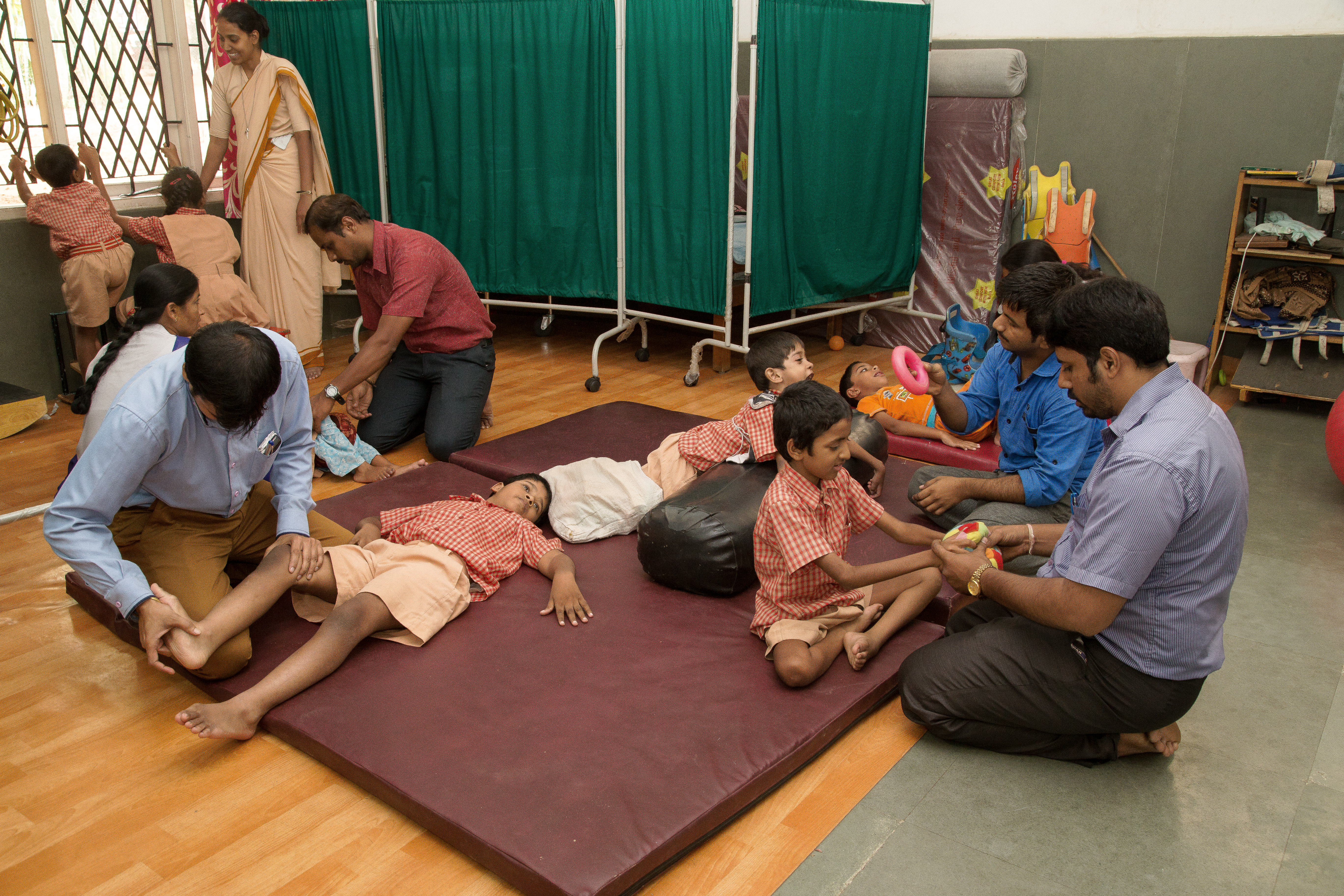
Non-governmental organizations play a pioneering role in the support and rehabilitation of PWDs in India. These organizations not only provide assistance to those people who seek their services but they also reach out to the PWDs in distant locations and communities through various models of rehabilitation. The Association of People with Disability (APD) is one such organization, headquartered in Bangalore. In this report, we assess a few of their activities, and through this process, outline important issues of inclusion that PWDs encounter in India. This report is based on a discussion about the activities and approach of APD with its officials and a visit to its centres in Bangalore and in different parts of the Bijapur district of North Karnataka.
2. Key activities
The founding of this organization in 1959 is rooted in the experience and exposure of N S Hema, who was affected by Polio. APD has been involved in providing treatment and rehabilitation to people with different kinds of disabilities, including those with spinal cord injuries, speech and hearing and visual difficulties, cerebral palsy, mental retardation and to some extent, mental illnesses, in areas in and around Bangalore. They have also extended their programs to rural Karnataka in partnership with government and non-governmental organizations. More about the activities of APD is available on their website.
Here, we take up a few salient aspects of their work. APD acknowledges that disability rehabilitation is not merely a medical or a health issue, but more a social, human rights and justice issue. PWDs encounter multi-dimensional barriers, and hence, APD follows a `Combination of Social and Human Rights model of disability’. The non-availability of support services for PWDs is just one of the problems. The accessibility of PWDs to common services, and also the ones specifically aimed at them is limited. Physical access, financial constraints and the attitude, awareness and behaviour of people, in general, create a larger set of barriers for them. There are people who may not access available services because of their lack of awareness of how the quality of their lives can improve by means of rehabilitation. APD aims at using `combined and coordinated use of medical, psychological, social, educational and vocational measures for training and retraining the individual to achieve the highest possible level of functionality’. It is obvious that there is a need for various kind of support for a person with disability. For example, a child with disability may require personalized therapy, additional nutrition, medical and surgical intervention, early and completion of education, assistive and adaptive devices, physical access to school and other public places and support to utilize the benefits offered by governmental organizations. APD attempts to ensure access to all of these mandated by the Rights of Persons with Disability Act, 2016 and the United Nations Convention on the Rights of Persons with Disability (UNCRPD); and, working closely with the government machinery, as well as, with other stakeholders. A favourable policy environment and budgetary provisions are key to the success of these programs. At APD, after a PWD is identified, he/she is allocated to a trans-disciplinary worker who coordinates the support on the following multiple fronts.
- Early intervention and inclusive education: APD carries out screening of infants for early identification of disabilities, provision of different levels of therapeutic services, counselling for the psychological and mental health of parents and children and for the provision of assistive and adaptive devices. It runs a school for inclusive education at its headquarters where children with and without disabilities study together (more details, later in this document). It also supports the process of special education in other parts of Karnataka through the training of teachers and the placement of trained teachers in districts and sub-districts.
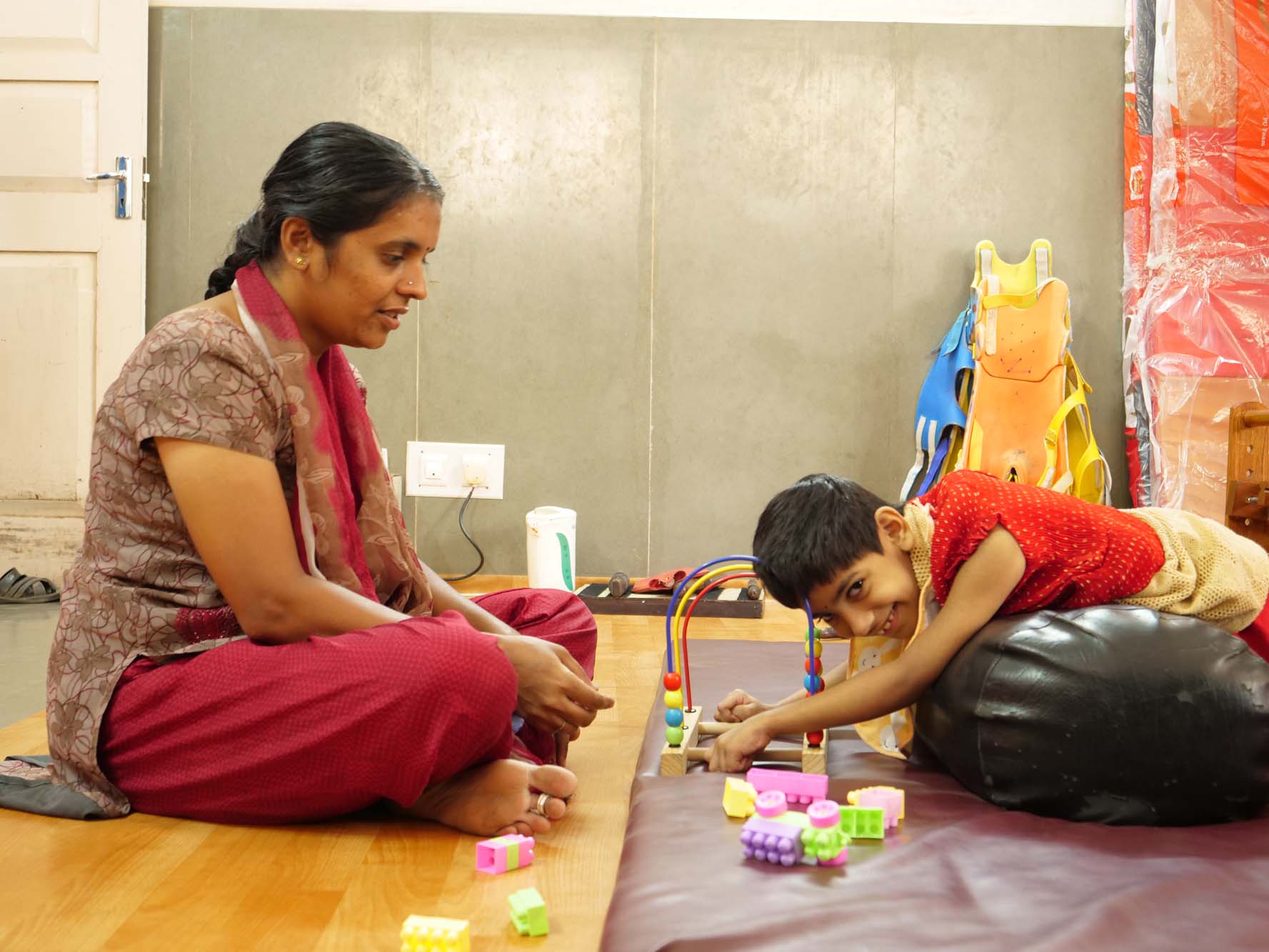 There are three kinds of such schools where APD provides collaborative support – around 400 plus rural government schools get support for including children with disabilities from the locality, these are called community schools; 35 model schools which have around 12-15 students with disabilities, get a higher level of support; and, it also collaborates with a few private educational institutions to establish and run inclusive schools on a Build, Operate and Transfer (BOT) model. Children with disabilities are supported under two plans, the Individual Rehabilitation Plan (IRP) and the Individual Education Plan (IEP).
There are three kinds of such schools where APD provides collaborative support – around 400 plus rural government schools get support for including children with disabilities from the locality, these are called community schools; 35 model schools which have around 12-15 students with disabilities, get a higher level of support; and, it also collaborates with a few private educational institutions to establish and run inclusive schools on a Build, Operate and Transfer (BOT) model. Children with disabilities are supported under two plans, the Individual Rehabilitation Plan (IRP) and the Individual Education Plan (IEP). - Livelihood support: APD provides skill-enhancement and livelihood support activities to PWDs. Apart from a number of non-formal courses, APD runs a foundation course on life-skills and employer-led training activities in the domains of BPO (Business Process Outsourcing), hospitality and retailing to help students with disabilities find employment. The collaboration with potential employers for this purpose is very useful. The organization also runs an Industrial Training Institute (ITI) which offers a two-year diploma/certificate course and provides young PWDs with livelihood skills and helps them in leading a life of dignity.
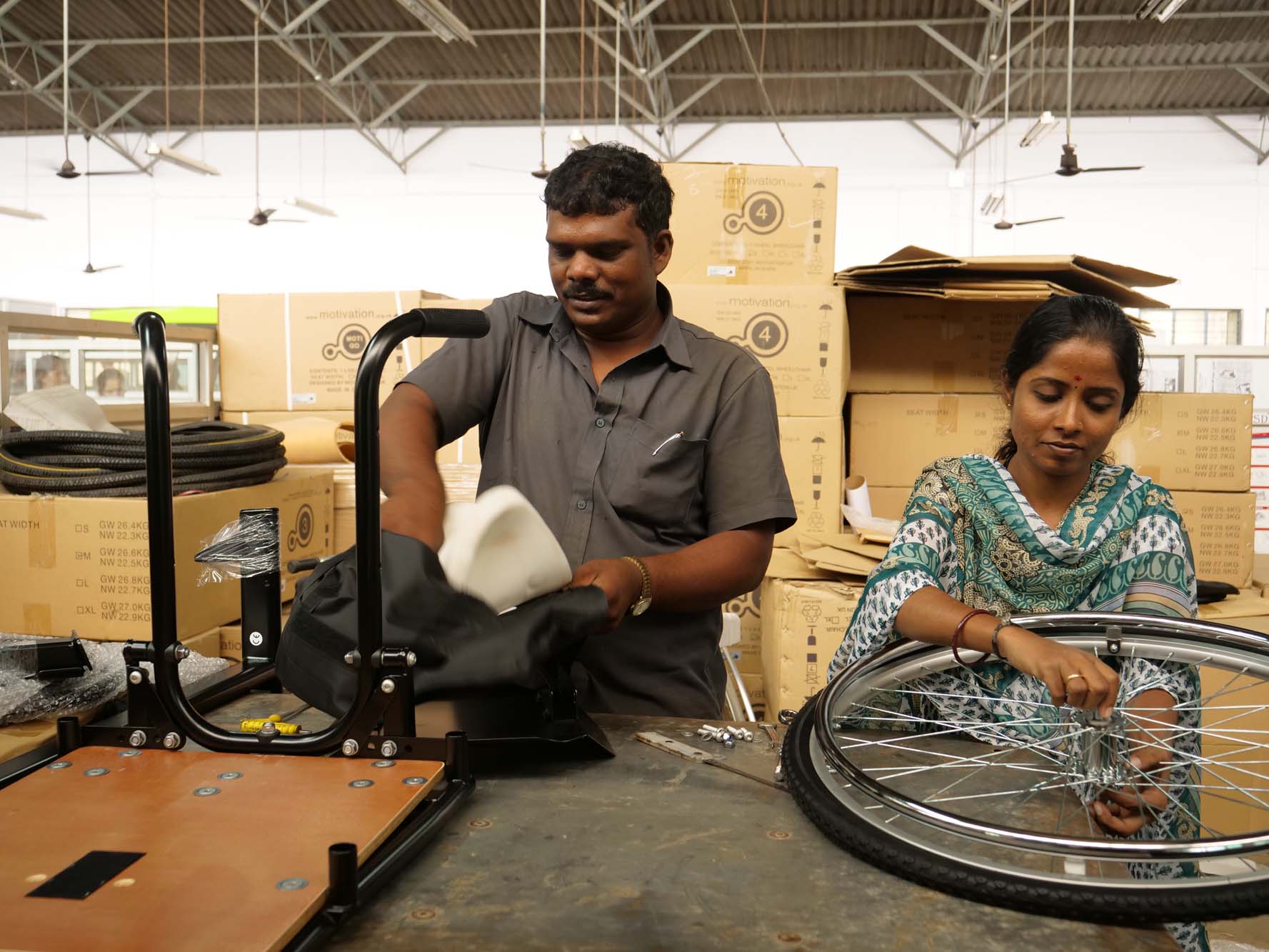 The Association has successfully mobilized employers to provide a minimum salary of Rs. 13,000 per month to these students. One of their oldest models of livelihood that has been running successfully is horticulture. APD provides horticulture training to up to 150 students in a year and places them with various corporates, gardens and plant nurseries. The founder, N S Hema believed that horticulture is not only a source of livelihood but also works as therapy. APD claims that PWDs have shown significant improvements from their involvement in horticulture activities. In addition to this, APD also promotes self-employment of PWDs by facilitating their access to finance and by connecting them with agencies which provide assistance in this regard.
The Association has successfully mobilized employers to provide a minimum salary of Rs. 13,000 per month to these students. One of their oldest models of livelihood that has been running successfully is horticulture. APD provides horticulture training to up to 150 students in a year and places them with various corporates, gardens and plant nurseries. The founder, N S Hema believed that horticulture is not only a source of livelihood but also works as therapy. APD claims that PWDs have shown significant improvements from their involvement in horticulture activities. In addition to this, APD also promotes self-employment of PWDs by facilitating their access to finance and by connecting them with agencies which provide assistance in this regard.
- Spinal cord injury rehabilitation: There are special efforts being made for the rehabilitation of people with spinal cord injuries (SCI). These are mostly adults who have met with road accidents or have suffered falls (in risky occupations, such as coconut-picking or as linemen climbing electricity poles). The Spinal Cord Injury Rehabilitation (SCIR) centre in Bangalore runs a comprehensive residential therapy program. In addition, there are also community and home-based support systems for people with spinal cord injuries. At present, as per the PWD Act, disability due to SCI comes under the general locomotor disability category because of which these patients do not get the specialized support they need from government schemes. Also, the number of people with SCI recognized by the state government is far less than the actual number.
- Treatment and support services: APD provides various levels of support services. Those who require intensive interventions get the service every day. There are others who need and get it three to four times per month and yet others with who the contact is limited to once a month or once in three months, as per their requirements. Services are also provided indirectly, such as through facilitators like ASHA workers who are trained by APD. The organization also ensures parental and family involvement in the treatment and rehabilitation of PWDs by enhancing their capacity.
- Advocacy and partnerships: APD takes up advocacy for PWDs so that they get the benefits of government policies and schemes; and, for the creation of accessible environment and sensitization of different stakeholders like government officials and elected representatives. It runs a number of programs for this purpose using innovative and cost-effective technologies for training from distance. In cases where APD does not have adequate capacity to provide the support required by the PWDs (for example, surgical interventions) it partners with other organizations. It carries out accessibility audits of schools, government buildings and other spaces to advise and assist in making the physical environment barrier-free. It also trains PWDs in advocacy to communicate their demands to the state and other stakeholders.
- Metal health awareness: APD creates awareness on mental health issues in rural areas. The Association carries out the initial screening after which it refers cases to the District Mental Health Centres. APD also provides counselling and the follow-up of medical treatment. In the Davangere district, APD reaches out to one thousand people with mental illnesses for their rehabilitation in partnership with the National Institute of Mental Health and Neurosciences (NIMHANS). These are significant measures because of the lack of awareness about mental illnesses and the willingness to take treatment for these in our country.
- Assistive devices: At a workshop in APD, innovative assistive devices and equipment needed by PWDs are assembled and manufactured. These include rollators, walkers, special chairs, crutches and standing table. 3D printers are used to develop devices that fit well to provide support in correcting postures and preventing deformities. APD has a centre for orthotics and prosthetics in Bangalore and has plans for another mobile unit in North-Karnataka soon.
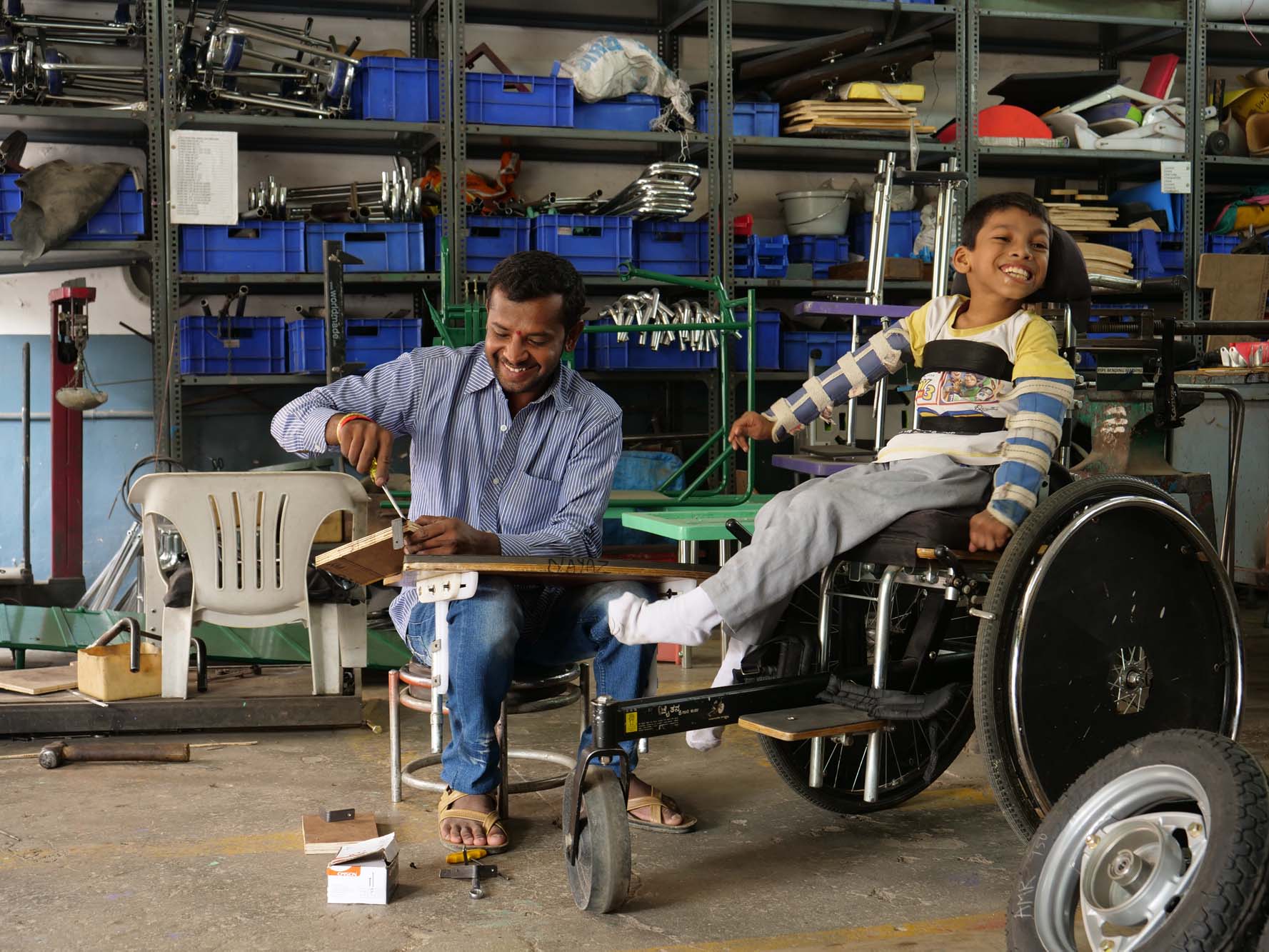
- Training and research: APD is contributing significantly to the education of management and care for the PWDs. The Institute of Disability, Rehabilitation and Research (IDRR) at APD offers a one-year certification course on rehabilitation therapy and a nine-month course for caregivers of PWDs. It also offers non-formal courses in Indian sign language, community-therapy aid and inclusive education.
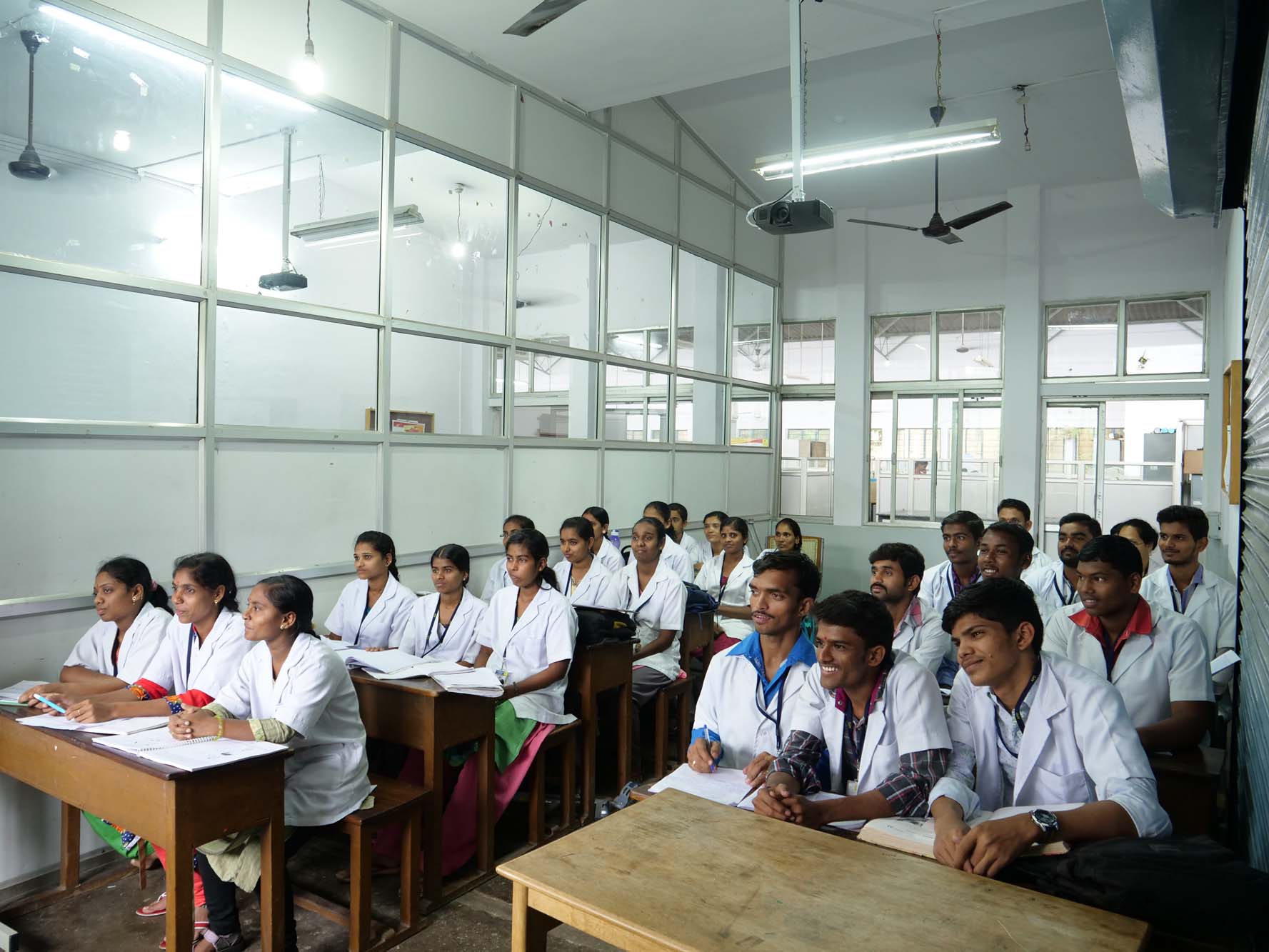 APD carries out research and documentation on disability-related issues. It has also developed and adapted software tools for the tracking and monitoring of the rehabilitation of the PWDs registered with it.
APD carries out research and documentation on disability-related issues. It has also developed and adapted software tools for the tracking and monitoring of the rehabilitation of the PWDs registered with it.
3. Inclusive Education
Issues that surround the education of children with disabilities in India are complex and must be viewed within the context of the challenges that the country faces in providing quality education to children in general. Historically, children with disabilities have been confined to special schools. It is only recently that a shift towards bringing them into the mainstream has taken place, in policy as well as, in practice. However, it is not hard to observe that children with disabilities continue to remain nearly ‘invisible’ in regular schools and classrooms.
The last couple of years have seen several policy and legislative measures in the form of the SSA (2000), RTE (2009), and RPD (2016) that wholeheartedly lend support to the idea of inclusion of children with disabilities in the regular school system. The situation on the ground, however, sketches a different reality. Current official estimates suggest that about 2.35 million children with disabilities are enrolled in elementary schools (NEUPA, 2014) across states in India. While this data shows a substantial increase in the number of children with disabilities being enrolled in elementary school over the years, a closer look at disability-wise data reveals that nearly 50% of children across all disabilities and more than two-thirds of children with severe disabilities continue to remain out of school. Add to this is the absence of a meaningful and empowering educational experience, wherein the individual needs of each child are met.
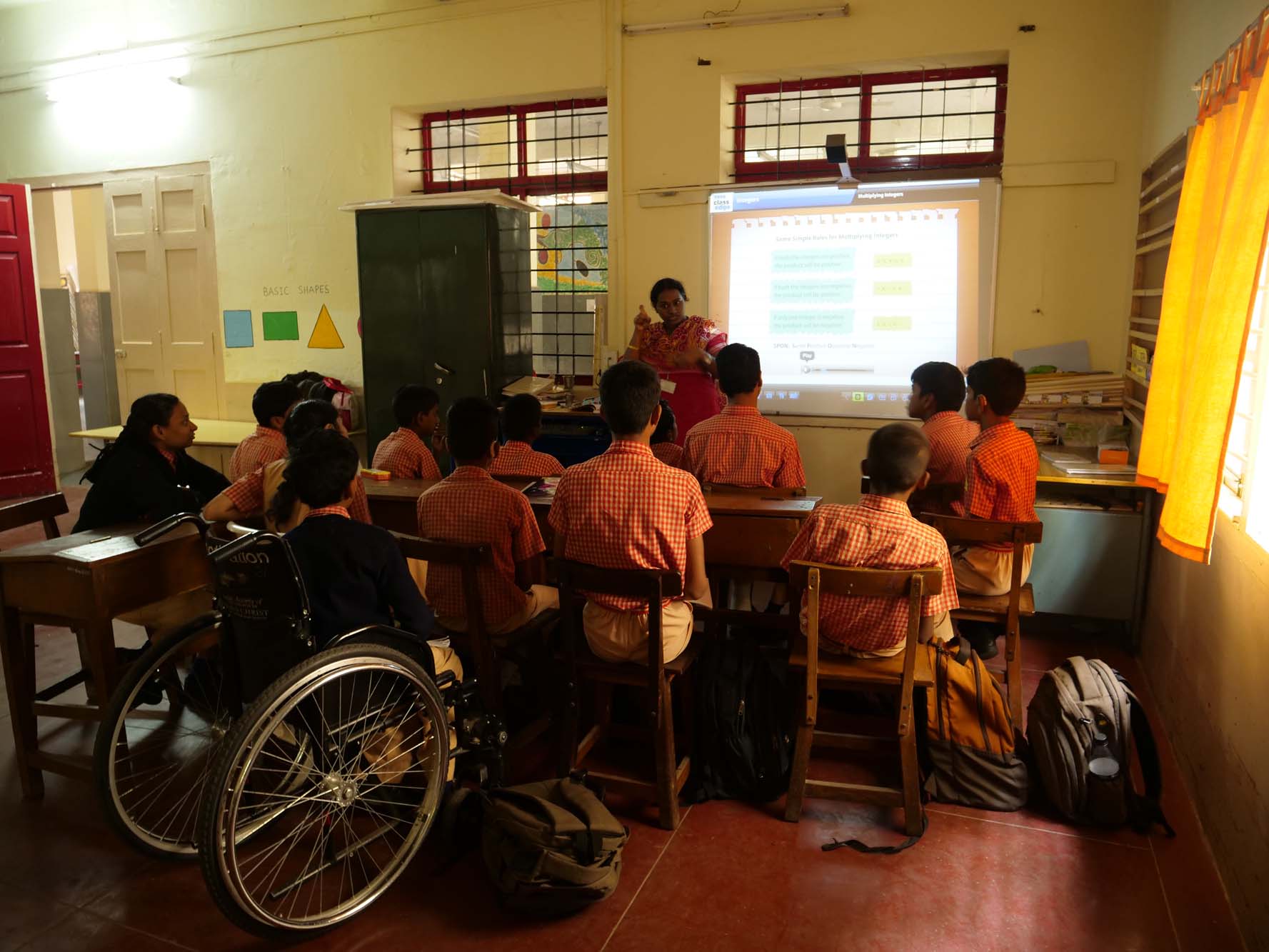
Several reasons may be attributed to this failure. One of which is that the discourse on inclusive education (IE) in India has been marred by nebulous misinterpretations and misunderstandings. Debates about what it means and how can it be translated into practice have overwhelmed much of the deliberations on it so far. There seems to be little consensus even in policy documents on how IE can be realized in practice. Broadly, it is agreed at least theoretically, that IE is concerned with ‘all’ children. It is seen as a transformative process to increase access (or presence) of all children into school systems; enhance the acceptance of all children; maximize students’ participation in all domains of activity; and, increase the achievement levels of all children (Artiles, et.al 2006, 65-108). The demand for IE for children with disability arose in the West challenging the restrictions to ‘access’ and ‘participation’ imposed by the then existing models of integration and mainstreaming. The development of the social definitions of disability influenced the critique of the role of education, and special education in particular, in the oppression and exclusion of people with disabilities. In India, the concept started to gain impetus only in the nineties with the launch of several schemes and policies that favoured the education of children with disabilities in regular schools as opposed to special schools. The IE program at APD is discussed here against this background.
3.1 Shraddhanjali Integrated School
The Shraddhanjali Integrated School at APD was set up 45 years ago at a time when the concept of IE was essentially unknown and not even a part of the educational discourse within the academia in India. Located in the premises of the headquarters of APD in Bangalore, this school currently caters to about 164 children of which 128 are children with disabilities. The rest 36 children belong to the community living around the APD campus and are all from the socio-economically weaker sections. Children with mild to severe disabilities ranging from locomotor, spinal cord injuries, cerebral palsy, mental retardation, hearing impairment, low vision and multiple disabilities attend this school. The school has 16 regular teachers, one special educator, a counsellor, and one visiting teacher for arts and crafts. Some of the teachers have received RCI (Rehabilitation Council of India) certified diplomas in special education specifically to work with children with hearing impairment and cerebral palsy. The children with disabilities are mostly admitted to the school through the early intervention outreach program run by APD. The non-disabled children are admitted without any screening or admission tests.
The medium of instruction in the school is English and it follows the Karnataka State Board syllabus up to grade VII. After grade VII, children are enrolled in regular government schools in the neighbourhood with whom APD has long-term relationships of extending multilevel support. In addition to attending classes, children undergo physiotherapy, occupational therapy, speech and language therapy and psychological counselling sessions every day to suit their individual needs. Apart from the fairly large classrooms, the school has facilities like a computer room, a dining hall, a multipurpose courtyard, a sensory park (outdoor play area), and therapy rooms for physical, occupational and speech training. Under the midday-meal scheme, the children receive lunch from Akshaya Patra. The single-storey building is equipped with ramps and rails for support to children on wheelchairs and those with locomotor disabilities. Walls are colourfully painted and cheerfully decorated with bold signages marking places in the building.
As one goes around the school, what strikes the most is the casual abandon with which children with various disabilities interact with one another, lending a hand in pushing a wheelchair here, holding a door open for a child with a walker there, or using gestures to communicate a point to a hearing-impaired child elsewhere. The non-disabled children go about their school-day in a completely nonchalant manner, extending help wherever it is needed. Similar attitude also prevails among the teachers and the support staff. For instance, in a grade II classroom, the teacher was teaching subtraction to a group of 13 children seated in two neat rows. Some children had locomotor disabilities and there were at least a couple of children with hearing and speech impairment. While the teacher did not use any special modifications in her teaching to deal with the multiple special needs of her students, she used gestures, repetition and showed tremendous patience to allow all the children to grasp the concept at their individual pace. A similar scene was observed in an outdoor activity being conducted among grade IV students. Here the English teacher was practising a rhyme with a group of around 15-17 students with emphasis on performing actions. In this group, at least seven to eight children were in wheelchairs with impairment in both upper and lower limbs. As the rhyme progressed and the children performed multiple actions, one could see that the teacher as well as the children without disabilities and those with less severe mobility issues, enabled their peers to participate in the activity by pushing their wheelchairs around and holding their hands up to ensure they got the actions right. Excitement writ large on their faces, grade IV children seemed to thoroughly enjoy the outdoor English lesson.
As the children progress through the grades, problems of coping with the rigour of the state board syllabus force many with severe challenges to drop out of school. Currently, there are only ten children in grade VII. It is hoped that all these children will be included in regular government schools in the next academic year. As part of the student support program (SSP), the school continues to support children who leave school after grade VII in their academic work through regular interaction with the school social workers and special educators. In addition to this, having partnered with schools in the vicinity over the years, the school participates in the capacity-building of their teachers by offering regular training programs in special education. Parent involvement is sought through structured capacity-building, monthly meetings and regular sessions on the care and hygiene of children with severe disabilities.
The Shraddhanjali Integrated School at APD is a model of special education program that is not very common in our country. With a ratio of 80:20 of children with disabilities against those without disabilities, the school makes a shift from the typical special school structure where only children with one or two types of disabilities are admitted and specialized instruction is given within an institutionalized framework. Such models defy principles of inclusion and are now being phased out. At the other end of the spectrum is the model of inclusive school which has a majority of non-disabled children but admits children with all disabilities and makes accommodations to its infrastructure, curriculum and pedagogy to suit their individual needs. Based on this description, one may ask, can the school at APD be called an inclusive school? With a cautionary note, one might say that it is indeed an inclusive school. It is inclusive because it admits all children, without making any distinctions on the basis of the type and severity of their disability. It has made infrastructural modifications to accommodate the needs of the children based on their disability and individual needs. The school also makes modifications, albeit small, to its curriculum and pedagogy to cater to children with various types of disabilities. Teachers are empowered, sensitized and trained to work with children and parental support is provided. Above all, one experiences an ambience of cooperation, peer support, collegiality and joy everywhere on the campus. Of course, it would be more desirable if the ratio of children with and without disability were more equal and the classroom practices were more differentiated, but it is important that the inclusion be seen as a process and not an end. The Shraddhanjali Integrated School, after all, is a microcosm that reflects the exclusionary mindset of the society where one of the greatest challenges that a school faces is to convince parents of children without disabilities to send their children to school with children with disabilities.
3.2 The possibility of model schools
We have seen different models of IE followed by APD. Since their inclusive school is not residential, it caters only to children from the urban area where it is situated. The children come from poor households. However, as noted earlier, APD collaborates with others, including government schools, for the education of children with disabilities in rural areas. The `community schools’ (government schools to which APD provides a certain level of support) have a few children with disabilities. However, given the intensity of support (both in terms of infrastructure and trained people) required even if there are only a few children with disabilities, it may not be practical to provide every manner of support to all of these community schools. It is in such a scenario that ‘model schools’ are advocated. One school among a set of (say 10-12) community schools is chosen where adequate infrastructure and time of a set of trained people are provided. There may be 25-35 students with one or the other kind of disability who come from the catchments of a number of village schools. They can be provided with safe transportation to and from this model school. This seems to be a viable model that can be used within Karnataka and also in other states. Though there may be a temptation to provide some support for special education in all schools, such support may not be adequate given the limited amount of resources available with the governments. On the other hand, the BOT model used by APD wherein it works with private schools, and also where some of them charge a fee for education, may not be the most suitable for providing schooling to all disabled children.
4. Key Challenges
It is obvious that persons with disabilities need support from governments and society. Though the main source of support is their family, this support may not be adequate even in well-to-do families. Making public spaces accessible to PWDs requires public investments. As for the poor and other vulnerable households, the care of the disabled member (who is a generally also a non-earning member) may add to their financial vulnerability. For these reasons, there is a need for mobilizing financial resources from multiple sources, which is a significant challenge faced by governmental and non-governmental organizations. All issues in this regard cannot be comprehensively addressed by the government. The care of PWDs requires close interaction, emotional support, and a compassionate approach, and hence, concerned individuals and non-governmental (altruistic) organizations too have an important role to play. Some of the specific issues in this regard as observed by us are discussed below.
- Unethical medical practices: PWDs can become victims of unethical medical practices especially when medical and healthcare in India are dominated by for-profit enterprises. The anxiety of family and their financial and other vulnerabilities may enhance the prevalence of these unethical practices. So, while there is a need for better availability of medical facilities for PWDs in India, there is also a need for greater caution and regulation against the possible misuse of the available facilities. This is an issue that requires the attention of non-governmental organizations working in this domain.
- Need for innovative approaches for funding: There are funding agencies and individuals willing to provide financial support to PWDs. Those people who have themselves experienced a disability or have a family member with a disability are also at the forefront of mobilizing support for PWDs in general. However, there could be a tendency among funding organizations and others to provide funding on the basis of visible targets, like the distribution of a large number of wheelchairs. However, such a blanket distribution may not be useful in meeting specific, individual requirement. Such support underestimates the requirement of PWDs on multiple fronts. Hence, there is a need for funding agencies to internalize a `social model’ of the care for people with disabilities.Though APD receives funding from different organizations and individuals, it has not made a significant effort to increase the funding from individuals. The latter can be a relatively better source of funding for two reasons: (a) a large number of individuals may be willing to provide financial support; and (b) they are less likely (less able) to restrict how the organization chooses to spend their funds. Hence, it may be desirable to mobilize more resources from this source.
Currently, even though APD only manages to recover a small percentage of the costs from its patients, it has not attempted to charge a higher fee from those who can afford to pay. A cross-subsidy model (where there are different levels of payment and a part of the revenue from those who can afford to pay is used to meet the cost of those who cannot due to financial vulnerability) in healthcare is implemented by several socially concerned organizations and APD too may benefit from trying out this model. - Making governmental schemes more effective: Of late, central and state governments have come out with a number of schemes to provide financial and other support to people with disabilities. This also includes a mandatory allocation of resources from all tires of the government (including local governments) and also reservation in government jobs. Organizations such as APD, whose policy and advocacy teams work with governments in this regard will need to push harder to make these government schemes effective. Governments too will have to act beyond making schemes for the PWDs to improving implementation by focusing on creating awareness and sensitization in the community by better behavioural change activities, bringing multiple stakeholders together, improving education system; and, setting up more disability support and resource centres.
- Focus on prevention: Several disabilities can be avoided through prevention. Wearing of safety devices and caution in jobs like driving and climbing electricity poles can prevent spinal cord injury to a great extent. Disabilities among new-borns can be reduced by proper maternal care during pregnancy, prenatal care, and also through early screening strategies. However, our understanding is that there are not enough efforts in this direction by governmental and non-governmental organizations in India. This is an issue that requires a higher prioritization by the funding and non-governmental organizations.
- Expanding the availability of services in rural areas: Despite the effort made by APD to reach the rural population in collaboration with government and other organizations, our impression is that there have to be greater efforts to make the life of the PWDs in rural Karnataka better. The services available in rural areas are not at par with those in the urban localities. This is true about most parts of India. One can see a gradual increase in the willingness to use available services for PWDs even among the poor and lower middle-class people in the country. We could see both mothers and fathers and from households with limited means, such as that of an auto-rickshaw driver, taking time off to bring their children with disability to centres for physiotherapy and other services. However, there could be a section of Indian parents who are not aware of or who cannot afford these services. The availability of therapeutic and counselling services for PWDs are also scarce in many parts of India. This could be an issue of economic and social development. The willingness to take preventive measures, the willingness and affordability to use available services and also the readiness of the state and non-state actors to respond to such a `demand’ may depend on the level of human development in a specific context. Hence, one should not be surprised to see different equilibriums in this regard considering the wide variations in terms of human development between different states and regions within India. Hence, addressing the basic issue of human development is important in improving the lives of PWDs and also probably, in reducing the percentage of the population with one or more disability in the country. This is also valid for the provision of appropriate education for children with disabilities. Hence, the care of people with disabilities cannot be seen in isolation from the efforts to achieve higher levels of human development in the country.
AUTHORS
V Santhakumar, Professor, Azim Premji University
Ankur Madan, Faculty, Azim Premji University
Subrat Mishra, Program Manager, Field Practice and Students Affairs, Azim Premji University

